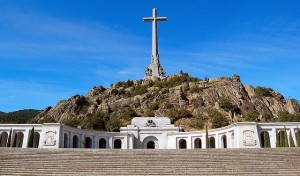Here’s a question: is the Valley of the Fallen (Valle de los Caídos) a religious shrine: a Benedictine monastery and Roman Catholic basilica that includes a memorial to the dead in the Spanish Civil War, along with the tomb of General Francisco Franco?
Or is it a grotesque monument to hate, an enduring reminder, built by its victims, of a military dictatorship that murdered and imprisoned hundreds of thousands of people whose only crime was to have defended democracy?

Coming up with an answer will be the task of a newly appointed 13-member commission. It’s been given five months to decide, once and for all, what to do with the Valley of the Fallen. (What do you think should be done? Vote in our poll on the Iberosphere homepage.)
Why has it taken so long to address the question? How is it that almost four decades after the death of Franco the monument retains the legal status given it by the dictator in 1959: a religious site run on a day-to-day basis by a foundation overseen by Benedictine monks, but which is part of the National Heritage’s inventory of historic buildings?
The center-left governments after the death of Franco also set up a commission to try to decide, but failed. Then came two right wing Popular Party administrations with no reason to tackle the question.
The commission has been told by the government that the 150-meter cross atop the basilica will stay, as will the monastery and the basilica. A memorial is to be constructed to honor the more than 34,000 souls buried in niches in the basilica’s crypt, as well as to the Republican prisoners who worked on the site.
Its members have also been told that it should “include among its objectives the rehabilitation of all those who died as a consequence of the war and the repression that followed and that it should deepen our understanding of this period of history and our constitutional values.”
What to do with Franco’s bones?
As if that weren’t enough, they must also decide on the final resting place of the dead: those in the crypt, along with General Franco and José Antonio Primo de Rivera, the founder of the Falange Movement, and who was killed in the first months of the Civil War.
Some say that while Franco and Primo de Rivera remain on the site the Valley of the Fallen will always be their monument; their bodies should be removed and placed in family graves. Of course that would require the permission of their respective families. Franco’s daughter has said that she wants her father to stay in the Valley of the Fallen.
And the bones of mainly Nationalist soldiers in the crypt? Their names are recorded and their families could be contacted…
Perhaps the best that can be hoped for is a debate about the past, about the many issues that Spaniards have dodged during the first years of the transition.
And one of the most complicated questions, and which is represented so tangibly by the Valley of the Fallen, is the place of the Roman Catholic Church in Spanish society.
The blurring of Church and State
The Catholic Church has yet to apologize for its active and sustained support of Franco during and after the Civil War, and the important role it enjoyed in running the country alongside the military regime.
And since the return to democracy, despite Spain’s secular system, wherein Church and government are separated, the Roman Catholic Church remains an important force. This is a country where less than 10 percent of the population attend mass, but still consider themselves Catholics. So around half of all marriages still take place in church, the vast majority of children are baptized and receive communion, and the dead are still often given a funeral mass.
The Roman Catholic Church has fought hard against education reform, measures to speed up divorce, gay rights, and of course a woman’s right to choose over abortion.
If the men and women who wrote the Spanish Constitution back in the late 1970s had shown a little courage and foresight, they would have taken tougher measures to limit the role of the Church in Spanish life, copying the approach of France, notably in terms of not allowing the Church any role in delivering education, other than through its own, self-funded schools, and by severely limiting state funding to allow the Church to provide social services. But they didn’t, and now the Roman Catholic Church has entwined its interests with those of the Popular Party, strengthening its role in political life further.
Most on the commission agree that their task is to demythologize the Valley of the Fallen, to defuse the symbolic sway it exercises over the victors and the vanquished.
But of course to begin doing that, they will first have to agree on just what the Valley of the Fallen is.
Leave a Reply
You must be logged in to post a comment.